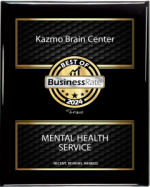What is Post-Traumatic Stress Disorder (PTSD)?
Post-traumatic stress disorder (PTSD) is a mental health disorder that some people develop after they experience or see a traumatic event. The traumatic event may be life-threatening, such as combat, a natural disaster, a car accident or sexual assault. But sometimes the event is not necessarily a dangerous one. For example, the sudden, unexpected death of a loved one can also cause PTSD.
It has been known by many names in the past, such as “shell shock” during the years of World War I and “combat fatigue” after World War II, but PTSD does not just happen to combat veterans. PTSD can occur in all people of any ethnicity, nationality, or culture and at any age. PTSD affects approximately 3.5 percent of U.S adults every year, and an estimated one in 11 people will be diagnosed with PTSD in their lifetime. Women are twice as likely as men to have PTSD.

What Causes Post-Traumatic Stress Disorder (PTSD)?
Researchers don’t know why some people get PTSD and others don’t. Genetics, neurobiology, risk factors and personal factors may affect whether you get PTSD after a traumatic event.
Who is at Risk for Post-Traumatic Stress Disorder (PTSD)?
Many risk factors play a part in whether you will develop PTSD. They include:
- Your gender; women are more likely to develop PTSD
- Having had trauma in childhood
- Feeling horror, helplessness or extreme fear
- Going through a traumatic event that lasts a long time
- Having little or no social support after the event
- Dealing with extra stress after the event
- Having a history of mental illness or substance use
What are the Symptoms of PTSD?
Symptoms of PTSD fall into four categories. Specific symptoms can vary in severity:
1-Intrusion:
Intrusive thoughts such as repeated, involuntary memories; Flashbacks may be so vivid that people feel they are re-living the traumatic experience or seeing it before their eyes.
2-Avoidance:
Avoiding reminders of the traumatic event may include avoiding people, places, activities, objects and situations that may trigger distressing memories. People may try to avoid remembering or thinking about the traumatic event. They may resist talking about what happened or how they feel about it.
3-Alterations in cognition and mood:
Inability to remember important aspects of the traumatic event, negative thoughts and feelings leading to ongoing and distorted beliefs about oneself or others (e.g., “I am bad,” “No one can be trusted”); distorted thoughts about the cause or consequences of the event leading to wrongly blaming self or other; ongoing fear, horror, anger, guilt or shame; much less interest in activities previously enjoyed; feeling detached or estranged from others; or being unable to experience positive emotions (a void of happiness or satisfaction).
4-Alterations in arousal and reactivity:
Arousal and reactive symptoms may include being irritable and having angry outbursts; behaving recklessly or in a self-destructive way; being overly watchful of one’s surroundings in a suspecting way; being easily startled, or having problems concentrating or sleeping.
Many people who are exposed to a traumatic event experience symptoms similar to those described above in the days following the event. For a person to be diagnosed with PTSD, however, symptoms must last for more than a month and must cause significant distress or problems in the individual’s daily functioning. Many individuals develop symptoms within three months of the trauma, but symptoms may appear later and often persist for months and sometimes years. PTSD often occurs with other related conditions, such as depression, substance use, memory problems and other physical and mental health problems.
How is PTSD Diagnosed?
A healthcare provider at Kazmo Brain Center who has experience helping people with mental illnesses can diagnose PTSD. The provider will do a mental health exam and may also perform a physical exam. To be diagnosed with PTSD.
What are the Treatments for Post-Traumatic Stress Disorder (PTSD)?
The main treatments for PTSD are psychotherapy, medicines or both. PTSD affects people differently, so a treatment that works for one person may not work for another. If you have PTSD, you need to work with a mental health professional to find the best treatment for your symptoms. Kazmo Brain Center is the most comprehensive private mental health clinic in North Texas, which can help you with PTSD.
Psychotherapy, which can teach you about your symptoms. You will learn how to identify what triggers them and how to manage them. There are different types of psychotherapy for PTSD.
Medicines can help with the symptoms of PTSD. Antidepressants may help control symptoms such as sadness, worry, anger and feeling numb inside. Other medicines can help with sleep problems and nightmares.
Can Post-Traumatic Stress Disorder (PTSD) be Prevented?
There are certain factors that can help reduce the risk of developing PTSD. These are known as resilience factors, and they include:
- Seeking out support from other people such as friends, family or a support group
- Learning to feel good about your actions in the face of danger
- Having a coping strategy or a way of getting through the bad event and learning from it
- Being able to act and respond effectively despite feeling fear
Recourse: medlineplus.gov
Kazmo Brain Center is a counseling center located in Frisco, Texas specializing in post-traumatic stress disorder and will work with you toward a happier and more satisfying life. If you are facing problems and you think that you need aid in fixing them, Kazmo Brain Center can do excellent help.







